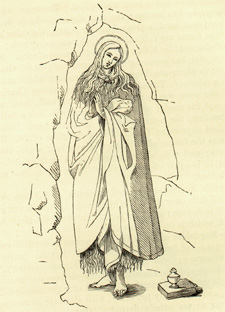Home |
|
 |
Iconography of St. Mary Magdalene In all these subjects the accompanying attribute is the alabaster box of ointment, which has a double significance : it may be the perfume which she poured over the feet of the Saviour, -or the balm and spices which she had prepared to anoint his body. Sometimes she carries it in her hand, sometimes it stands at her feet, or near her; frequently, in later pictures, it is borne by an attendant angel. The shape varies with the fancy. of the artist; it is a small vase,-a casket, a box, a cup with a cover; more or less ornamented, more or less graceful in form; but always there-the symbol at once of her conversion and her love, and so peculiar that it can leave no doubt of her identity. |
|
The Life of St. Mary Magdalene Taken from--Jameson. Sacred
and Ledgendary Art, vol. I. London: Mary Magdalene was of the district
of Magdala, on the shores of the Sea of Thus far the notices in the Gospel
and the suggestions of commentators: These things being accomplished, Mary Magdalene retired to a desert not far from the city. It was a frightful barren wilderness, in the midst of horrid rocks and caves; and here for thirty years she devoted herself to solitary penance for the sins of her past life, which she had never ceased to bewail bitterly. During this long seclusion, she was never seen or heard of, and it was supposed that she was dead. She fasted so rigorously, that but for the occasional visits of the angels, and the comfort bestowed by celestial visions, she must have perished. Every day during the last years of her penance, the angels came down from heaven and carried her up in their arms into regions where she was ravished by the sounds of unearthly harmony, and beheld the glory and the joy prepared for the sinner that repenteth. One day a certain hermit, who dwelt in a cell on one of those wild mountains, having wandered farther than usual from his home, beheld this wondrous vision-the Magdalene in the arms of ascending angels, who were singing songs of triumph as they bore her upwards; and the hermit, when he had a little recovered from his amazement, returned to the city of Marseilles, and reported what he had seen. According to some of the legends, Mary Magdalene died within the walls of the Christian church, after receiving the sacrament from the hand of St. Maximin; but the more popular accounts represent her as dying in her solitude, while angels watched over and administered to her.
|
